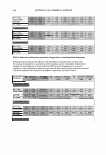ADHESION FAILURE IN HAIR 367 Figure 17. Multiple step fractures from stretching hair previously bleached and permed (S. Ruetsch, private communication). SEM by S. Ruetsch, TRI Princeton. controlled systematically. Scale lifting caused by bending deformations (Figure 18) during fiber knotting, especially in the dry state, is very similar to extension-caused scale lifting and most likely involves outer beta-delta failure, particularly at low and moderate RHs. However, the condition of the hair and other variables must be considered to understand this phenomenon more fully. ADHESION FAILURE FROM ALTERNATING TREATMENTS OF ANIONIC AND CATIONIC SURFACTANTS Alternating treatments of anionic and cationic surfactants on hair fibers that have been previously permanent waved can provide adhesion failure and scale lifting (Figure 19). This type of failure occurs only in damaged hair, and it occurs more readily on hair that has been permanent waved on the head and stressed by shampooing, combing, and other stresses that are normally encountered in everyday wear. Hair permed in the laboratory can also provide this effect, but not to the same degree. Hair permed in the laboratory and then combed responds more than uncombed and permed hair, but still not to the same degree as hair permed on the head and exposed to normal wear and weathering actions. Extensively bleached hair can also provide this type of response, but not to the same degree as hair permed on the head. Undamaged hair does not provide this type of adhesion failure. As indicated above, alternating treatments of anionic and cationic surfactants can pro duce this effect. In this reaction, anionic surfactants that are larger and more hydrophilic
368 JOURNAL OF COSMETIC SCIENCE Figure 18. Bending and failure of adhesion by knotting a hair fiber (1). Photograph reproduced with permission of Springer-Verlag. such as sodium deceth-3 sulfate or sodium laureth-3 sulfate do not produce this failure as readily as TEA dodecyl sulfate or sodium lauryl sulfate. Cationic surfactants such as cetrimonium chloride and benzalkonium chloride provide the most failure and scale lifting when applied alternately with salts of lauryl sulfate. In general, those combina tions of anionic and cationic surfactants that most readily form water-insoluble cationic anionic complexes produce the most failure, while those that do not tend to form water-insoluble complexes, such as sodium deceth-3 sulfate with tetradecyl trimonium chloride, do not tend to produce this failure. Since permanent waving is essentially a prerequisite to this condition, and perming produces this effect more readily than bleaching, we believe that cleavage of the thioester linkage between the outer beta layer and the hydrophobic keratin protein (Figure 2B) is involved because this bond has been shown to be sensitive to strong nucleophiles like amines and mercaptans (3,22) (see Figure 20). This reaction of TGA in the cuticle cuticle CMC weakens the outer beta layer by cleaving thioester linkages through nu cleophilic displacement with TGA, creating a hydrophilic structure from a hydrophobic one at the cuticle membrane region of fatty acid attachment (hydrophobic keratin protein (b) in Figure 2A) rather than at the delta layer attachment (see the monolayer model in Figures 2B and 20). The next step involves penetration of cationic surfactant into this site and bonding by salt linkage to the newly formed anionic sites in this weakened region. Subsequently, anionic surfactant penetrates and reacts to form an
Purchased for the exclusive use of nofirst nolast (unknown) From: SCC Media Library & Resource Center (library.scconline.org)






































































































